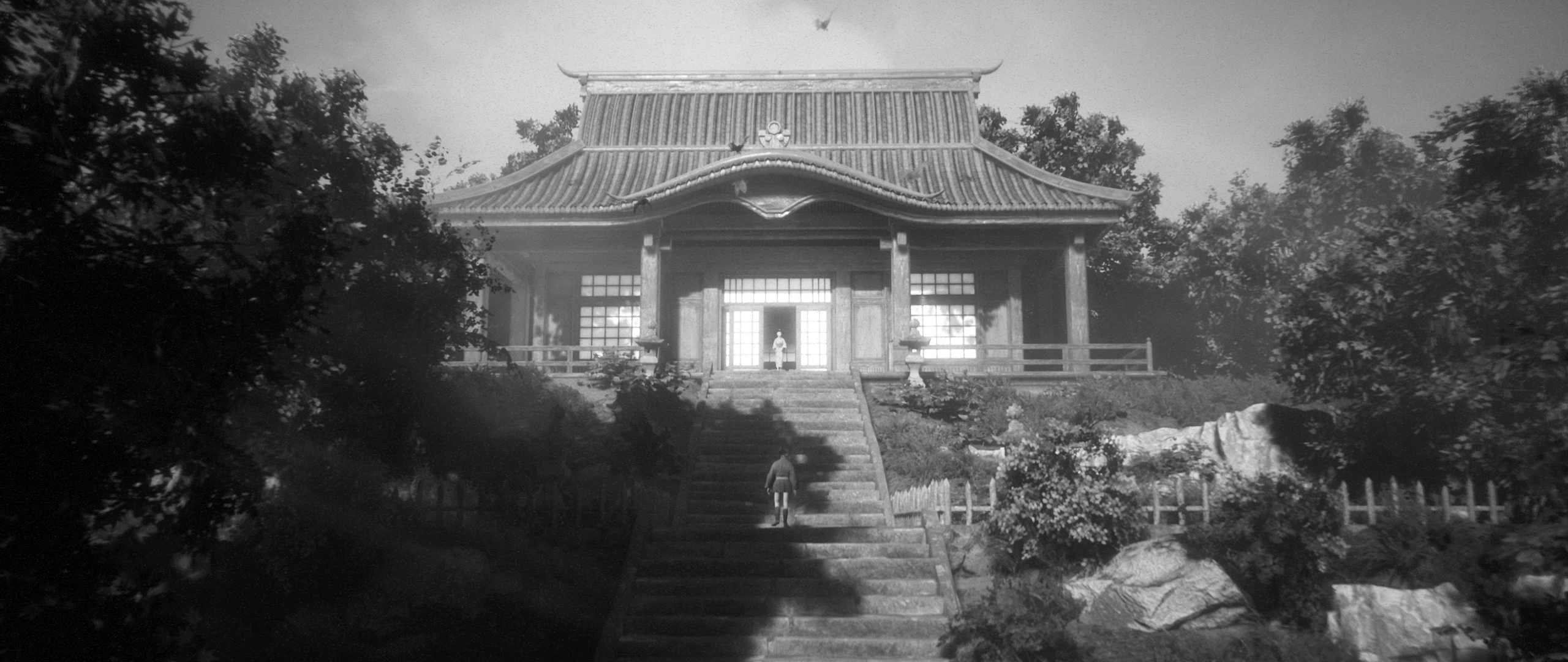When the samurai action side-scroller Trek to Yomi was announced nearly a year back, its shadowy black and white visuals of ancient Japan made it a game that the Checkpoint crew were interested in hearing more about. What made it even more exciting is the team behind the game; it’s developed by Flying Wild Hog, the devs of the Shadow Warrior series and Leonard Menchiari who was behind the Eternal Castle remake back in 2019. Therefore, I was pretty excited to spend some time with a preview copy of Trek to Yomi.
The first words heard in the preview is in Japanese and comes from the protagonist Hiroki’s sensei Sanjuro. This symbolises the importance that he has in Hiroki’s life and foreshadows the promise that he will do anything to keep – to protect his daughter and his town. You play first as a young Hiroki, shaggy haired and wiry, learning basic moves from Sanjuro. The opening is pretty standard visually, but this is obviously done for a reason.
The reason being that as soon as you leave the dojo and traverse down into the village, the game’s art style hits you square in the face; and what a delightful punch it is. I could tell straight away that Menchiari’s main influence was Kurosawa movies due to the way the camera plays with light and angles so beautifully. An interesting and affective touch is the way that the screen flickers ever so slightly, like you are playing the game through an old 50s cinema projector. Hiroki isn’t the main focus in this area, it is the town itself and the way its inhabitants complete their daily routine like a dance in steady, flowing movements. Everything is said in Japanese with English subs and as you pass by, many stories are being told. Here the only thing you need to worry about is moving Hiroki forward and eavesdropping on stories of family, romance, and all the simple yet complicated aspects of life.
The game’s world is mainly a side-scroller, though there are moments where Hiroki can move down certain areas and through certain doorways. The game urges you to explore and rewards you for doing so via health/stamina upgrades, collectibles, and extra bo-shurikens, aka throwing stars. The weapons you have access to in the preview are your katana and three bo-shurikens. Once the stars are thrown, you cannot retrieve them, but, as mentioned, you will be able to refill your supplies throughout your run.

Once you are out of the main thoroughfare, you realise your town is being invaded by bandits and that your sensei has led the charge in defeating them. You now have to make your way through a bunch of bad guys, saving town folk along the way to reach Sanjuro. Wielding the katana is mostly smooth with two light or one heavy hit being enough to defeat most basic enemies. The parry will be your best friend as this throws off the enemy and lets you get in at least one slice of your blade.
There are combos that you can perform and there is also a move to “turn around” as you cannot simply press backwards on your controller or keyboard to face Hiroki in the right direction. This can be a little clunky, as is throwing the bo-shurikens, which you cannot aim at enemies. In the preview, I could only perform face on attacks as your sword will stay sheathed unless you are in battle. Therefore, I could not perform stealth takedowns with sword or using the bo-shurikens, though there were opportunities to create environmental hazards that would kill enemies without detection.
“…the screen flickers ever so slightly, like you are playing the game through an old 50s cinema projector.”
I did find killing enemies very easy and I was playing on “normal” mode. There is also a story and difficult mode if you want to take it easier or want your butt kicked extra hard. Perhaps the devs made the “normal” mode deliberately easy as they want players to enjoy a more relaxed experience so that the beauty of the world can be the star rather than gameplay. Or perhaps the difficulty will be raised after feedback. Shrines, where you can save your progress and heal, are very readily available. Killing enemies can become a bit repetitive, especially seeing as most of the baddies you are faced with are wearing the exact same “bandit” outfit. Apparently the full title will also include a bow and small hand cannons, making me think that combat will become more varied as you make your way deeper into the game. There are also extras throughout the game such as artefacts that work as collectibles and as you progress, and different move sets that become available to you.

Whilst chapter 1 focuses on Hiroki as a child, chapter 2 sees our hero when he is older, married to Sanjuro’s daughter and the protector of his town. Once again, bandits attack and Hiroki must save a number of the village’s men who have been kidnapped. In this chapter, the locations are more varied as you venture deeper into the surrounding world of the town. You go through an underground mine that has curving tunnels and across or through mountains. Though the story trailer does show Hiroki interacting with elements of the afterlife, this is not shown in the preview. The preview works like a prologue that sets the scene of Hiroki’s world and what is important to him. It will be very exciting to see how the devs include storytelling and gameplay elements that delve deeper into Shinto mythology.
From what I have seen of the game so far, Trek to Yomi has the potential to be a stunning full-length samurai action-adventure experience. I’m going to keep this game on my radar and look forward to slicing and dicing my katana through baddies once it’s released sometime in 2022! It will release on PC, PS4, PS5, Xbox X|S, Xbox One, and it will be a day one release on Xbox Game Pass.





